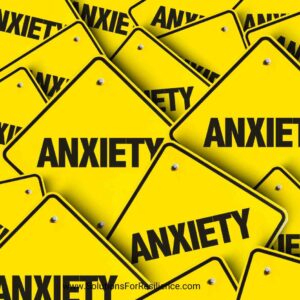Avoid an Anxiety Attack with Five Ways to Calm
 Tips to Manage Anxiety
Tips to Manage Anxiety
She arrived looking tense and shaky. She had just had an anxiety attack before arriving for her counselling session.
Most of us have moments of worry, stress and feeling anxious. It’s normal. Although, I often tell my clients, “You can find normal on the drier between low and high.”
As a professional speaker I like to experience a certain dose of healthy anxiousness. It heightens my focus, energy, and desire to do a good job. Anxiety is related to fear. I fear public shame on the platform; fear of letting down the people who pay me, or fear of disappointing my own performance standards. However, it is a problem when our feelings of fear and anxiety become overwhelming. Then anxiety interferes with our performance, rather than enhancing it.
You know you are in trouble if you have a cluster of symptoms.
Signs of an Anxiety Attack:
- Tremble, twitch or shake.
- Feel constricted in your throat or chest.
- Rapidly breathe with an increase in heart rate.
- Have restless, tossing and turning sleep.
- Feel a sense of hyper-vigilance or dread.
- Are distracted and struggle to concentrate.
- A sense of hanging on.
If you put this cluster of symptoms together you describe a full-out anxiety attack! Being anxious to this extreme is not only frightening and exhausting, but debilitating.
Your heart pounds. You sweat. You shake. Your thoughts run like a stampede. You imagine the worst—as if going over a cliff. You might even imagine you will die.
Difference between Distress and Anxiety
Feeling anxious and feeling distressed are sometimes confused.
Definition of Stress is, a state of mental or emotional strain or tension resulting from adverse or very demanding circumstances. Sometimes we feel stressed because our day or life is not what we want it to be. We struggle to accept and let go.
Definition of Anxiety is, a feeling of worry, nervousness, fear, or unease, typically about an imminent event or something with an uncertain outcome.
When we feel anxious we imagine our situation is more dangerous than it is. Fear kicks in but it is a distorted sense of fear because our life is typically not at risk. Our thoughts tell us we are in danger. Most of the clients I see who deal with anxiety attacks are triggered by a childhood trauma. We work to reveal that they now have choices and coping strategies.
That anxious woman in my office had anxiety attacks every time she entered a car. It was interfering with her family relationships and daily living. We discovered that when she was 6 years old, she became ill in the backseat of the family car. She vomited. The adult driver pulled her out of the back seat and gave her a spanking. From that day forward she felt anxious at the mere thought of getting into a vehicle.
The good news: when we concluded therapy, she was taking driver’s education classes. She faced her fears, eventually saw them as unrealistic and rewired her brain and nervous system. She was able to calm down her childhood memory and cope with the minor danger of driving on the road.
For less dramatic examples of anxiety some pro-active strategies can help. On strategy is learn to make yourself present.
Five Ways to Calm Anxiety
- Be with your breath. Focus on it. Watch your breath as it inhales and exhales through your nose. Don’t force it. Notice it! Rest your eyes on a flower, a candle or close them. Let your breath move lower and lower into your body, expanding your rib-cage. Imagine the breath moving down and out of your feet.
- Make an appointment for a massage. Let the massage therapist know what would make you most comfortable and then ease into the experience. Really notice what having zero body tension feels like.
- Journal. Write about the thoughts that are creating anxiety in your body. Describe how your body feels. Talk to yourself on paper. Get it all down from inside out.
- Find a good therapist. Panic attacks can be effectively dealt with. Absolutely! I’ve witnessed it in a number of clients.
- Use some humor. See if you can laugh at the illogical absurdity of your anxiousness.
Alert: Anxiety can Indicate Living with Trauma
Trauma is unresolved distress from past events or conditions, often rooted in an adverse childhood. There are several indicators that can suggest a connection between anxiety and trauma. It’s important to note that everyone’s experience is unique, while reviewing these common signs
- Intense or Irrational Fear: People with trauma-related anxiety might experience intense fear or panic in situations that don’t seem threatening to others. This fear can be triggered by reminders of the traumatic event.
- Flashbacks: Recurrent and intrusive memories of the traumatic event can lead to flashbacks. These can be distressing and make a person feel as though they are reliving the trauma.
- Avoidance: Individuals with trauma-related anxiety might go out of their way to avoid situations, people, or places that remind them of the trauma. This avoidance behavior can be a coping mechanism to prevent distress.
- Hypervigilance: People who have experienced trauma may be constantly on edge, hyperaware of their surroundings, and easily startled. This heightened state of vigilance is a response to feeling unsafe.
- Physical Symptoms: Trauma-related anxiety can manifest in physical symptoms such as rapid heartbeat, sweating, trembling, and gastrointestinal distress.
- Negative Thought Patterns: Individuals might experience persistent negative thoughts about themselves, others, or the world. This can lead to feelings of hopelessness and a distorted sense of danger.
- Emotional Numbing: Trauma survivors might disconnect from their emotions as a way to cope with overwhelming feelings. This can lead to a general sense of emptiness or difficulty feeling joy.
- Interference with Daily Life: When trauma-related anxiety is severe, it can interfere with a person’s ability to function in their daily life, impacting work, relationships, and overall well-being.
- Somatic Symptoms: Some individuals may experience physical symptoms without an underlying medical cause, such as headaches, muscle tension, and pain. These symptoms can be a somatic expression of the emotional distress from the trauma.
- Substance Abuse: People might turn to alcohol or drugs as a way to cope with the distress caused by trauma-related anxiety.
If you or someone you know is experiencing these indicators, it’s important to seek professional help from a therapist, counselor, or mental health professional. Trauma-informed therapy can help individuals address the underlying trauma and develop healthy coping mechanisms to manage anxiety.
Whatever you do, don’t remain vulnerable to scary anxiety attacks! Do something different, nourishing and helpful!





September 25, 2019 @ 11:35 am
Excellent and timely article re Anxiety, Patricia. I’m working with a teenager from another province who is struggling on several levels, anxiety being one of them. this will be a helpful resource for next session with my client. thank you!
September 25, 2019 @ 12:32 pm
Hi Annette,
I am glad to read that this blog is helpful. Anxiety is more commonly dealt with than most people realize. It is often rooted in a childhood experience because we have few choices and are dependent on adults for our safety and well-being. Trauma in the adult years can also be the root. Examples include domestic abuse, witnessing violence, a car accident, or a bully boss. Please let your teenager know she is ‘not her anxiety.’ Her body is letting her know she had an experienced that her nervous system needs help resolving.
September 25, 2019 @ 6:36 am
So very helpful to be reminded of all I’ve learned through good therapists, like Patricia; actually mostly from Pat. Thank you so very much.
September 25, 2019 @ 9:41 am
Hi Irene,
Thank you, for reading and leaving your kind and acknowledging comment. Here’s to your continued resilience!